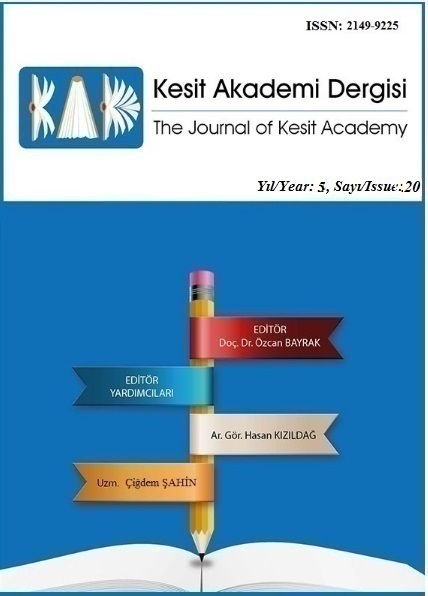“KÖKEN ARAYIŞININ SON BULDUĞU YER”: JEANETTE WINTERSON’IN THE POWERBOOK ADLI ROMANINDA POSTHÜMANİST DÜNYANIN TASVİRİ
Author :
Abstract
Posthumanizm ve teknoloji arasındaki bağ feminist eleştirmenlerin bedenlileşmeyi, insan bedenini doğal ve organik olarak varsayan biyolojik bir belirleyici olarak değil; akıllı makinelerin ve insanların birleşmesi olarak algılamasını sağladı. Bu makale, Deleuze ve Guattari'nin rizom ve Haraway'in sayborg kavramları üzerinden, Jeanette Winterson'un The PowerBook (2000) adlı romanında toplumsal ve biyolojik cinsiyetin temelinde yer alan bedenlileşme politikalarının ve ‘insan’ kavramının nasıl işlendiğini göstermeyi amaçlamaktadır. Yazarın sanal gerçeklik ortamı yaratması, maddesel ve soyut dünyaların sınırlarının belirsizleştiği, posthümanist bir dünyayı betimlemektedir. Aynı şekilde, romanın kahramanı Ali/Alix, bedeni sürekli akış halindeki bir içkinlik düzlemi olan insan-sonrası bir özne olarak betimlenmektedir. Makale, romanın, insan bedeniyle ilgili özcü algılarının da yıkılmasıyla, insan/insan olmayan, doğa/kültür, erkek/kadın, toplumsal cinsiyet/biyolojik cinsiyet, gerçek/sanal veya organizma/makine gibi ikili kategorileri reddettiğini öne sürmektedir.
Keywords
Abstract
The alliance between posthumanism and technology has opened a way for feminist critics to perceive embodiment not as a biological determinant essentialising the human body as natural and organic, but rather as the intertwinement of intelligent machines and humans. By highlighting Deleuze and Guattari’s concept of the rhizome and Haraway’s notion of the cyborg to bear upon Jeanette Winterson’s novel The PowerBook (2000), this paper aims to demonstrate how the text deals with the notion of the human, alongside practices of embodiment central to the organisation of gendered and sexed identities. The writer’s use of cyberspace depicts a posthumanist world, where the boundaries of physical and non-physical worlds become blurred. Likewise, the protagonist, Ali/Alix, is represented as a posthuman subject, whose body becomes a plane of immanence, by being in a state of constant flux. With the destabilization of any essentialist perception of the human body, it argues that the novel refuses any demarcation between human/non-human, nature/culture, male/female, gender/sex, real/virtual or organism/machine.
Keywords
- Barad, Karen. Meeting the Universe Halfway: Quantum Physics and the Entanglement of Mat- ter and Meaning. Duke University Press, 2007.
- Braidotti, Rosi. “Posthuman Critical Theory”. Critical Posthumanism and Planetary Futures. Springer India, 2016, pp. 13-32.
- ---, “Posthuman Feminist Theory”. The Oxford Handbook of Feminist Theory. University Press, 2016, pp. 673-697.
- Buchanan, Ian. “Deleuze and the Internet”, Australian Humanities Review, vol.43, 2007, pp. 1- 19.
- Deleuze, Gilles and Félix Guattari. A Thousand Plateaus: Capitalism and Schizophrenia. Uni- versity of Minnesota Press, 1987.
- Foucault, Michel. The Order of Things. Taylor & Francis e-Library, 2015.
- Grosz, Elizabeth. Volatile Bodies: Towards a Corporeal Feminism. Indiana University Press, 1994.
- Halberstam, Judith and Ira Livingston. Posthuman Bodies. Indiana University Press, 1995.
- Hayles, N. Katherine. How We Became Posthuman: Virtual Bodies in Cybernetics, Literature and Informatics. The University of Chicago Press, 1999.
- Haraway, Donna. Manifestly Haraway. University of Minnesota Press, 2016.
- ---. “Situated Knowledges: The Science Question in Feminism and the Privilege of Partial Per- spective”. Feminist Studies, vol. 14, 1988, pp. 575-599.
- Kember, Sarah. Cyberfeminism and Artificial Life. Taylor & Francis Group, 2003.
- Lykke, Nina. Feminist Studies: A Guide to Intersectional Theory, Methodology and Writing. Taylor & Francis Group, 2010.
- Makinen, Merja. The Novels of Jeanette Winterson. Palgrave Macmillian, 2005.
- Oppermann, Serpil. “Feminist Ecocriticism: A Posthumanist Direction in Ecocritical Trajectory”. International Perspectives in Feminist Ecocriticism. Taylor & Francis Group, 2013, pp. 19-36.
- Rajchman, John. The Deleuze Connections. The MIT Press, 2000.
- Winterson, Jeanette. The PowerBook. Vintage Books, 2000.
- Wolfe, Cary. What Is Posthumanism?. University of Minnesota Press, 2010.





